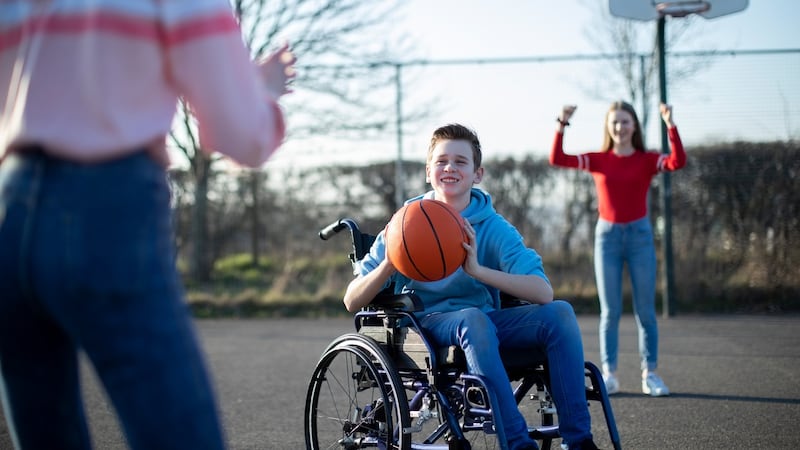As children approach their teen years, socioeconomic differences in their health begin to take hold and become "entrenched at 13", Dr Cathal McCrory, psychologist and research assistant professor at Trinity College Dublin explains.
The Growing up in Ireland study revealed that by age 13 "1.2 per cent of children from professional backgrounds and 2.9 per cent of children from semi-skilled/unskilled backgrounds reported as being 'sometimes/almost always unwell'.
“There are also pronounced differences in weight status,” Dr McCrory explains. “Children from semi-skilled/unskilled manual backgrounds are more than twice as likely to be obese, compared with children from professional backgrounds.”
When it comes to the sort of foods our preteens are consuming, the study also revealed the “socioeconomic differences in levels of fruit and vegetable consumption, and consumption of less healthy, energy dense foods”, Dr McCrory continues.
“For example, 86 per cent of children whose primary caregiver had a degree-level education consumed at least one portion of fresh fruit a day, compared with 71 per cent of children whose primary caregiver had a lower secondary education. By contrast, consumption of non-diet soft drinks was higher in the lower secondary (63 per cent) compared with the degree educated (40 per cent).”
The percentage of children participating in vigorous physical activity declines dramatically over the course of the preteen years. “The decline was much more pronounced among girls,” Dr McCrory notes. “Physical activity was socially patterned at 13 years of age with children from higher social class groups exercising at a more frequent intensity. Some of the differences may be ascribed to the ability to pay for discretionary sporting activities [eg gym memberships]. Although this is under-researched among children in Ireland,” he says.
“Sedentary activities are also patterned by socioeconomic status. For example, 27 per cent of children from professional social class backgrounds were watching TV for three or more hours a day compared with 38 per cent of those from semi-skilled/unskilled manual and never worked social class groups.”
And it’s not just our preteen’s physical health that is affected by socioeconomic circumstance. “Growing Up in Ireland used a short self-reported questionnaire called the Mood and Feelings Questionnaire to assess depressive symptoms among 13 year olds. “Reports of depressive symptomatology followed the characteristic social gradient at 13 years of age,” Dr McCrory explains, with those in lower socioeconomic households reporting higher levels of depressive symptoms.
With so much at stake, how do we best care for our pre-teens’ nutritional, physical activity level and mental health needs?
Nutrition
When it comes to nutrition for pre-teens "a healthy diet is important but a healthy relationship with food is the most important thing", says paediatric dietician Cathy Monaghan.
“Meals don’t need to be fancy and everyone doesn’t have to eat everything. Family meals work well if served buffet style, in the middle of the table.”
She believes it’s important to “try and make meals more about the conversation and less about the food” and advises that parents “try and not comment on who eats what”.

“Restrictive diets [eg veganism] are mainstream now,” Monaghan says. “If not supplemented correctly, restrictive diets can have a negative impact on health, especially in this the age group. If your preteen is keen to go on a restrictive diet it is a good idea to talk it through with a registered dietitian.”
While peers can play their part in influencing food choices, parental influence is still key as “research shows that most food is still consumed inside the home”, Monaghan explains.
Fussy eating can still be an issue at this age but Monaghan says parents need to have “realistic expectations”. “Your child is growing in independence; food is often something that they try and exert their control on first. Allow them some independence, she advises. “Ellen Sater’s old adage; ‘parent provides, child decides’ still applies. As parents it is our job to provide the meal. It is up to the child if and what they eat.”
Monaghan recommends to “share meals as a family. Avoid distractions [TV off, no phone zone etc]. Know what works in your home. There is no one way to do it,” she says. “Don’t be the meal police. Focus on the conversation and hearing their news!”
Put different bowls of food in the middle of the table, with something that everyone will eat
“Build family meals on carbohydrate/ protein and fruit and vegetables. Deconstructed meals work well for families – put different bowls of food in the middle of the table, with something that everyone will eat. Let everyone serve themselves.”
While many parents may worry about their pre-teen’s sugar and fat intake, Monaghan says that her bigger concern with this age group is restrictive diets. “As parents if we focus on what we provide at home then we have to learn to allow our children to make their own choices outside the home – we can’t control everything. Ideally they shouldn’t feel the need to hide anything they have eaten.
“I sometimes work with parents living in hotel accommodation. Access to cooking facilities/food storage is a problem, having a space to eat meals together, or trying to cook in a communal kitchen and look after children at the same time – that is a huge problem for some parents.
“Make mealtimes about family time, not about how much of what has reached your child’s stomach. Offer the meal and then your job is done. Enjoy your meal, have a conversation, find out about their day.”
Getting active
Children aged two to 18 should be doing 60 minutes of moderate to vigorous activity every day, says Alva O'Sullivan, nutrition and health coach, but "studies show less than 25 per cent of Irish nine to 12 year olds are reaching the recommended levels of physical activity – with girls less likely than boys to meet the recommended physical activity levels".
“There are a number of factors that contribute to the low level of physical activity being achieved in this age group, principally safety concerns, the increase of technology use and digital play, and busy family lifestyles,” she explains.
“Covid restrictions have had a huge impact on children’s physical activity levels. Lockdown saw a shutdown of all extracurricular classes, trainings, matches and tournaments as well as indoor and outdoor sports and recreational facilities, such as gyms, public swimming pools and playgrounds. Even with the relaxing of restrictions, sports activities have become highly regulated with much of the fun, spontaneity and social interaction being stifled.”
“Children aged nine to 12 years are in an important physical and developmental phase and the benefits of staying active are extensive,” O’Sullivan continues. “Regular physical activity improves children’s aerobic fitness, coordination, muscle strength and endurance. It also improves bone health and has been shown to reduce the risk of depression in children and build self-confidence. Studies show that regular physical activity can also have improved cognitive function, such as thinking and memory skills”.
Children don't need to join a sports club or be particularly interested in sports to be active
So with the benefits clear, how can we encourage increased activity levels?
“Children don’t need to join a sports club or be particularly interested in sports to be active,” O’Sullivan says. “The most important thing we as adults can do to help our children enjoy physical activity and feel the benefits of being active, is get active ourselves. When children see their parents exercising as part of daily life they grow up understanding this is ‘normal’ and what we do as part of our daily routine. Children are five times more likely to be active if their parents or guardians are.
“Ditch the car/bus and see if you can do some errands with the children on foot or on the bike during the week,” she suggests. “Play active games with your children – such as ball games, skipping, running games and encourage them every day to physically play.”
As for family favourites, it’s time to shake them up a bit. O’Sullivan suggests swapping sedentary family activities such as watching movies or eating out, with fun physical activities such as a mountain hike, a family cycle, or explore a forest trail.
“Let your children see you as a fit, healthy role model,” she says. “Don’t underestimate how influential you are in this way.”
Mental wellbeing
"There is not one single definite cause that impacts the mental health of children," says psychotherapist Susi Lodola. "There tends to be an interaction between psychological, biological and environmental factors that can lead to mental health issues."
How preteens might display mental health issues however, can be somewhat different to younger children. “Preteens could withdraw from social interactions, self-harm, change in eating habits, sleeping difficulties, tearfulness, avoiding school, headaches and drastic changes in mood and personality.”

A secure relationship with a child’s parent or caregiver is “hugely important” at any age, Lodola says. “Having a secure relationship is associated with less engagement in high-risk behaviours, fewer mental health problems, better social skills and better coping strategies, which is particularly important for the pre-teens and teens, as their brains are not yet fully developed.”
However, Lodola cautions, “in order to help your child become self-reliant and solve problems that come their way, you may have to resist the natural urge to pave a smooth path and solve all problems”.
“A better approach is to talk to your child about the issue, and brainstorm for possible solutions. By doing this you will firstly show your child they have a caring adult they can depend on, and secondly it will help them build confidence in their own ability to come up with solutions.”
There is, however, a balance to be struck. “Sometimes scooping them up and stepping in is exactly what they need,” she says. “Signs to look out for that you may have to step in are changes in your child’s behaviour, or physical changes, such as marks on their body, for example.”
Feelings of “not fitting in” will be experienced by most children as they develop, Lodola says. “It could be, for example, the child is socially awkward/shy, has a learning difficulty or has unusual interests. The desire to fit in and be more popular can cause extreme anxiety and sadness.
“Let your child know that you understand that it is hurtful for them. Explore with them how they feel about the situation. Show them consistently that they are accepted at home and get also validation from various different sources, like other family members for, example.
Having friends outside school is also a protective factor for dealing with problems in school
“You can help them connect to others through shared interests. There may be some after-school activities your child could take part in where they can meet children outside their school. Having friends outside school is also a protective factor for dealing with problems in school. As children grow older, they tend to accept their differences and will find peers they fit in with.”
When it comes to the source of many preteen battles – homework – Lodola says “the topic is a long-standing concern for mental health practitioners. There is research that has found that homework for under 11’s has no effect on their academic achievement. Young children need to spend time with their family and catch up with friends so they can refresh their minds and bodies. Life is about balance, and like adults, children need balance between work and down time.”
Lodola recommends that to best support their preteen’s mental health parents should ensure their child eats well and gets enough sleep and exercise. She also suggests facilitating “social interactions”, allowing them to “be bored”, letting them know they are loved and that you’re proud of them.
She advocates letting “them know it is okay to ask for help” and leading by example – “take care of your own mental health and talk about your own feelings with your child”.
Eat, move, think
Part 1: 0-8 years.
Part 2: 9-12 years.


















